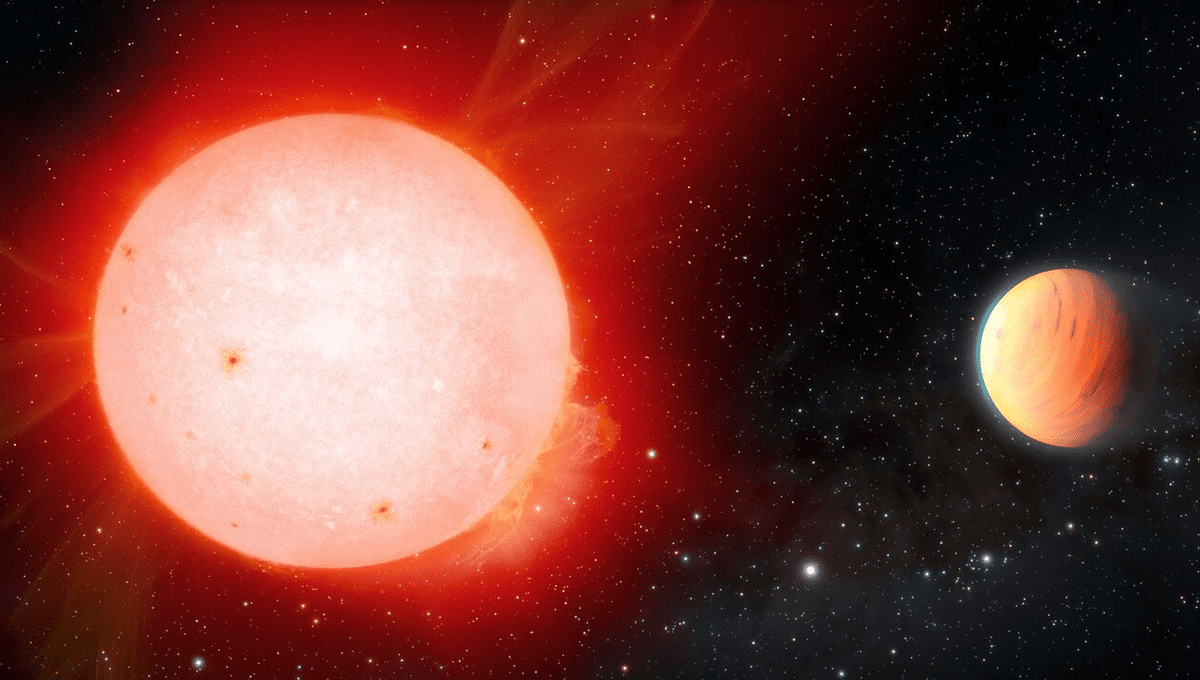
Patterns have emerged in the thousands of planets recently discovered orbiting stars besides the Sun. So when planets are found that break those patterns, astronomers get curious, particularly when they have been confident in their explanations for what they have seen.
The latest rule-breaker goes by the not-exactly rebellious-sounding name of TOI-3757 b and lies 580 light-years away in the constellation Auriga. Its radius is 10 percent greater than Jupiter’s, but its mass is barely a quarter as great. In fact, it’s the lowest-density gas giant ever found orbiting a red dwarf.
Saturn famously has a density lower than water, leading to children’s astronomy books sometimes picturing It floating on an immense ocean. TOI-3757 b is 60 percent less dense still; just 0.27 grams per cubic centimeter (0.037 pounds per cubic foot). The astronomers who found it have compared it to a marshmallow, so perhaps we need a giant hot chocolate in which it can bob.
Light as it is, if TOI-3757 b was orbiting a more Sun-like star it wouldn’t stand out. However, gas giants are rare around red dwarfs to start off with – just 10 have been found, 0.2 percent of known planets, so one so insubstantial requires explanation.
One clue to TOI-3757 b’s likely formation lies in the fact its parent star, TOI-3757, has the lowest metal abundance (astronomically defined as anything heavier than helium) of the red dwarfs known to have giant planets. The composition of the disk from which planets form reflects that of the star, so it’s likely heavier elements were in short supply when TOI-3757 b formed.
A second explanation the paper offers is that TOI-3757 b has an unusually elongated orbit for a giant planet. The authors suggest the internal heating produced by moving close to the star and then away again, as it does every 3.5 days, could cause the planet to puff up.
Some planet-star combinations are rare because our instruments aren’t well suited to finding them, such as those with masses smaller than Mars or in long orbits. However, it’s much easier to find gas giants than “super-Earths”, and we’ve found many of those. Consequently, astronomers are confident this is a pairing we have not under-sampled.
With such low density, TOI-3757 b is a particularly tempting target for the JWST and giant Earth-based telescopes now under construction to examine its atmosphere. It was initially discovered by the TESS telescope when it dimmed the light coming from its star, but some of that light reached us filtered through its outer atmosphere. This gives astronomers a chance to collect the spectrum produced and establish the composition of the outer layers.
“Finding more such systems with giant planets — which were once theorized to be extremely rare around red dwarfs — is part of our goal to understand how planets form,” Dr Shubham Kanodia of the Carnegie Institution for Science said in a statement.
The paper is published in The Astronomical Journal (Open Access).
Source Link: Gas Giant Planet With Density Of A Marshmallow Breaks All The Rules